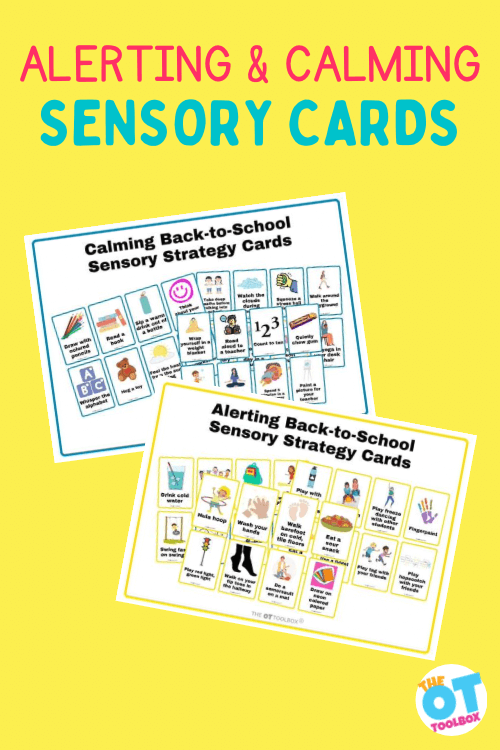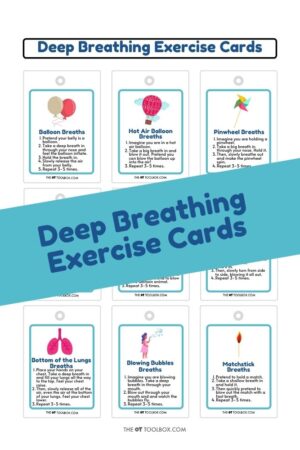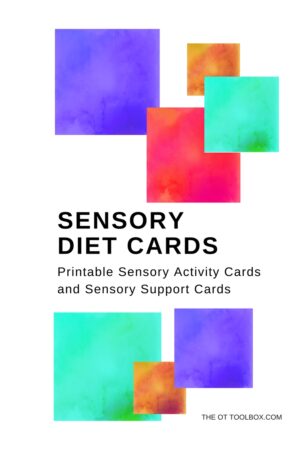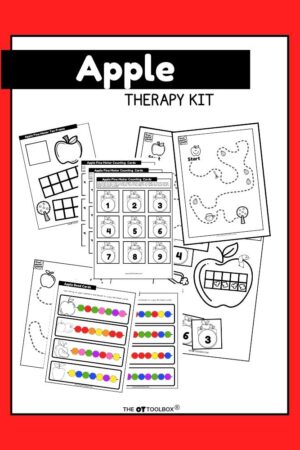Calming and Alerting Back-to-School Sensory Strategy Cards
$8.00
Sensory processing disorder simply defined is: the inability to take information in correctly from the environment to make meaningful output. Information is not being processed correctly. Sometimes the input is too much, other times too little.
Treatment becomes more complicated trying to determine when, how much, and what kind of input the body needs to regulate itself, or stay organized. Given some prior understanding of how sensory processing disorder works, these cards are full of great strategies for students of all ages. All students can benefit from these activities, not just those struggling with self regulation.
Calming and alerting strategies are not always straightforward. Many “hyperactive” children need more alerting activities in order to satisfy their sensory needs. Calming strategies work after the system has been satisfied. Students who are “zoned out”, appearing to need alerting strategies, might actually be overwhelmed with input. These students may need to get organized with some soothing strategies first. Take time to get to know each individual student when prescribing these cards.
Ways to use the alerting and calming strategies cards:
- Do sensory assessments and inventories prior to using these cards. Gather data about what triggers the student, and what tends to reorganize them.
- Pick two to four different card choices for the learning student,rather than presenting all 48 options
- Laminate the preferred card choices and put on a key ring for easy access
- Laminate and velcro the pictures to the student’s desk or choice board
- Post different picture options on the wall for students to select when needed
- Understand this takes trial and error. What works one day may backfire the next
- Try and jump in BEFORE the student is out of control or falling apart. Waiting too long may delay the process of self regulation and behaviors will interfere with the strategies
- Decide what strategies work for each student in their particular environment. While a student might love and benefit from playing tag or hula hooping, these might not be appropriate strategies in the middle of class time. Save these activities for recess, a class break, or PE
- Determine what strategies work, not just the ones that are favored. If given a choice, students will pick what seems the most fun, not the best option for them. Limiting choices for these students at certain times of the day, will be critical to success
- Educate the rest of the team, how and when to use the cards for the most success. Handing teachers a handful of cards will not be an effective method of treatment.
- Use the cards as part of an overall sensory diet with built in predictable breaks at critical times of the day.
Benefits of alerting/calming strategies:
- Learning only occurs when a body is in its just right zone. If the body is not regulated, very little learning will happen
- Maladaptive behaviors are the product of poor self regulation. Limit difficult behaviors by keeping students regulated
- Self regulation and awareness helps to overall keep the sensory system organized
- Language, and higher level reading/math/writing are dependent on a regulated body and mind
- Teachers are able to keep a calm and organized classroom if the students are regulated and organized
- Caregivers can expend their energy teaching students, rather than behavioral management
- A regulated student can handle change and unexpected transitions easier
- Social function improves with sensory regulation
These sensory alerting and calming strategies are a great addition to your toolbox. Add resources like the Sensory Lifestyle Handbook to put together an effective sensory program
Description
If sensory self regulation is part of your lesson or treatment plan, grab these 48 sensory strategy cards to teach alerting and calming strategies.
Sensory integration and regulation is confusing. Trying to decide what a student needs at the right moment, in the middle of a busy school day, can be very challenging. These strategy cards provide easy activities and exercises to do during the day to help keep students regulated.
These alerting and calming cards can be placed within a student’s reach, so they can learn to self regulate, and understand what they need, without being told. Self regulation is the ultimate goal of sensory therapy. A student who can advocate for themselves will be more successful than one who has to wait for someone to notice they need help.
With a little understanding of sensory processing disorder and treatment strategies, these sensory cards will be a great addition to your toolbox.






